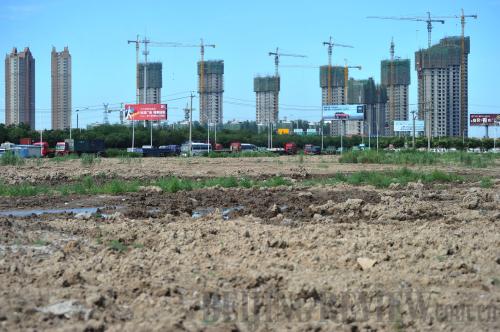|
 |
|
PRECIOUS LAND: High-rise apartment buildings in Binhai New District, north China's Tianjin. The land used to be rural construction land and was acquired by the local government for urban use (CFP) |
"Farmers can hardly benefit from the transfer of land ownership, which leads to frequent collision between farmers and local governments," said Zhou, who added that China's ongoing urbanization efforts rely on significant land reform.
In September 2013, China rolled out a pilot run on the free trade of rural construction land in 28 cities. Huang Xiaohu, Deputy Director-General of the China Land Science Society, said land reform has far-reaching significance on future growth and urbanization. "Right now, the time is ripe for carrying out such reform."
Great anticipation
Hopes are high for China's land reform and the potential it could have on food production and the country's ongoing economic transformation.
Zhou said more arable land supply could be realized by exploiting untapped rural land with modern technology. The Chinese Government has set a "red line" for the country's arable land, which says at least 1.8 billion mu (1 mu = 0.07 hectare) of arable land must be reserved to ensure China's grain production.
Zhou said his biggest hope for land reform is to solve the contentious issue of ownership over rural land. He suggested the government abolish collective ownership over rural land and make all rural land state-owned, just like urban land.
He also said that empowering farmers should be the main goal of land reform. "Land usage rights should be similar to property rights so that farmers can inherit, trade, collateralize and lease the land. The main direction of reform should be giving farmers property rights over the rural land." In terms of land trade, Zhou said the government's monopoly should be eradicated. "All land, no matter if it is owned by individuals or companies or the government, should have access to the market equally and freely."
Liu Shouying, Deputy Director of the Rural Economy Institute under the Development Research Center of the State Council, believed the goal of land reform should be to provide an institutional guarantee to China's economic transformation and sustainable urbanization.
"I hope the land reform can establish an equal ownership system for both urban state-owned land and rural land to ensure both are traded freely in the market."
But it's no easy task. Liu said relevant laws and regulations should be revised as soon as possible to ensure rural residents' usage rights over their leased farmland. He warned that land reform has an impact on every aspect of Chinese society and suggested a pilot run in certain areas before making it national policy.
Liu also advocated dividing land reform into three phases. The first phase, which would end by 2014, would see China register all rural land and greatly alter the way farmers are compensated. "The second phase will last from 2015 to 2017, when China builds a unified land trade market comprising rural and urban land. While the last phase would be from 2018 to 2020, when a modern land management system is established in the country."
Rural Land Acquisition
From 1996 to 2010, China turned 4.94 million hectares of rural land into urban construction land, causing over 30 million farmers to lose their land. From 2010 to 2020, another 3.5 million hectares of construction land will be needed, which is likely to leave 23 million farmers landless.
(Source: Ministry of Land and Resources)
Email us at: lanxinzhen@bjreview.com | 